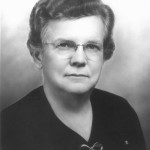How Gertrude Cox Blazed a Trail for Women in Statistics
June 8, 2016
 The field of statistics attracts a larger share of women than most STEM fields, and it’s partly because of the legacy of women like Gertrude Cox, one of the most important statisticians in history. Born in 1900, Cox left a mark on the field through her tireless work, and her passion for bringing statistics education to more people, particularly women and those in the south.
The field of statistics attracts a larger share of women than most STEM fields, and it’s partly because of the legacy of women like Gertrude Cox, one of the most important statisticians in history. Born in 1900, Cox left a mark on the field through her tireless work, and her passion for bringing statistics education to more people, particularly women and those in the south.
Cox started out as an undergraduate math major at Iowa State College. After graduating in 1929, she was offered an assistantship at the college’s computing lab, a rare position for a woman to hold at the time. This provided Cox the freedom to pursue what would become one of her most important legacies, the “Design of Experiment” class, which showed the practical application of modern statistics. The class was a hit on campus, and she encouraged all teachers and students, regardless of major or background to take the class, exhibiting early in her career a desire to make statistics education accessible.
Shattering Glass Ceilings in Academia
Cox continued to advance from there, and broke down barriers for women in STEM along the way. Her mentor at Iowa State College, George Snedecor, recommended her for a position as statistics department head at North Carolina State College. At the time, it was exceedingly rare for a woman to hold such as position. In fact, Snedecor was quoted as saying “…if you would consider a woman for this position I would recommend Gertrude Cox of my staff.”
Cox got the job, and it gave her a platform to pursue an even more ambitious dream of expanding statistics education in the south, and serving as a role model and mentor to women in the field.
With a grant from the state, she founded in 1946 the Institute of Statistics at North Carolina State College, which became the most distinguished statistics program in the country. She also was instrumental in founding the Research Triangle Institute (RTI) in North Carolina, one of the most prominent and influential research organizations in the nation, particularly in the areas of public health, the environment and technology.
A Mentor for Women
She used her increasing prominence to encourage women to enter the field, and more generally, to pursue a profession. In 1959 she wrote “I believe very strongly that girls should prepare for a profession,” and that “the field of statistics is certainly wide open to women…there are all sorts of opportunities to go as far as you wish.”
Because of the leadership of influential statisticians like Cox, the field of statistics and data science is a great one for women. See what some of today’s women statisticians and data scientists are doing in areas such as human rights, medical research, and technology.
Interested in other prominent women in statistics? Read about how Florence Nightingale was a pioneer in data visualization and other areas.
Sources:
http://www.amstat.org/about/statisticiansinhistory/index.cfm?fuseaction=biosinfo&BioID=2
https://www.lib.ncsu.edu/archivedexhibits/cox/career.html
http://www.nasonline.org/publications/biographical-memoirs/memoir-pdfs/cox-gertrude.pdf
Related Posts

Hindsight Is 2023 for Former Statistics and Data Science Students
It’s back-to-school season! Gear up for the upcoming semester and consider diving into the captivating world of statistics and data science. Looking for diverse job opportunities that span across every industry? Look no further! With a variety of graduate programs and jobs, now is a great time for students to become data scientists and statisticians….

Elizabeth J. Kelly: “Statistics is for Adrenaline Junkies”
Elizabeth J. Kelly has always loved math, and as a professional statistician at Los Alamos National Laboratory (LANL) and a recreational rock climber, Elizabeth is an avid thrill-seeker who enjoys a challenge. “Math reminds me of climbing, including the need to focus, problem solve and persevere. I guess I ended up in statistics because I…

